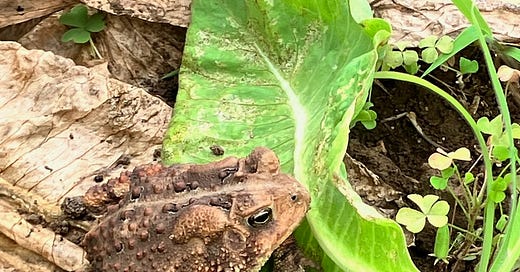I have been farming Organically for over thirty years. Used to get the farm certified Organic through OEFFA but quit in 2002. The reasons why are for another time but what I learned from being a certified Organic farmer is beneficial critters such as insects, amphibians, reptiles, and arachnids can be your best bet for pest control and one of the main reasons Organic farmers do not use synthetic inputs (read, herbicides, fungicides and insecticides) is because they tend to kill everything, including the life of the beneficials you want to preserve.
This toad lives in a lettuce patch under a bolted romaine plant next to an irrigation tape. Or it did. Sadly for the toad that plant was removed and either composted or fed to the ducks who turn it into great fertilizer. I am sure it has already found another suitable home in the tunnel. All it needs is some moist loose soil, some cover and a lot of food. The high tunnel has lots of both
Any hoo, this toad is a carnivore and will eat pretty much any animal that will fit in its mouth. Things like slugs, mice, flies, spiders (who are also good guys IMO), grubs, caterpillars, etc. It was likely born on the farm in the pond and will eventually go there to either lay or fertilize eggs and the next generation is assured. It is lucky to live in a place where it will rarely, if ever, be exposed to synthetic pesticides.
A couple of daddy long legs, AKA harvestmen. These are anachridq but they are not spiders, nor are they venomous, despite the myth that says they have the most deadly venom of all spiders. Again these are not spiders and they have no venom. They are omnivorous for the most part. They have been around for 400 million years and there are over 6500 species of them living on all continents except Antarctica. They eat slugs and snails, leaf litter, carrion, other arthropods, fungi, etc. Many of the species are becoming endangered because of pesticide overuse and ignorance thinking they can kill a human being.
This is a ladybug larva. It is speedy and hungry. It will consume hundreds perhaps thousands of aphids before it pupates into an adult ladybug. This guy lives in the pepper patch with many other ladybug larva. This is good because the peppers have a lot of aphids. This leaf it is on was covered with them but after a few hours, this tiny wonder cleaned them away better than any spray program could do.
Any Organic grower knows that using pesticides prophylactically is a bad thing to do because doing so rarely solves the pest problem and it usually kills off the beneficial insects and other critters that are waiting on the pest pressure to become great enough that it is worth their time to come in and consume the problem away. I expect in 3 to 4 days most of the pepper plants will be mostly free of aphids and there will be a lot of pupating ladybugs. They will hatch and consume more pest insects and keep our crops free of pests and disease.
That said, we do use pesticides on Boulder Belt Eco-farm, natural non synthetic pesticides that we use sparingly. We try to allow nature to deal with the issue first and if that doesn’t work we will step in so we don’t lose crops or harm yields. But even than we will do things like apply the insecticides at times when the insects are not busy in the crops and use things that have a short field reentry period, often as little as 10 minutes. Synthetics are generally designed to be very effective, i.e. killing things for days or even weeks. Natural ‘cides allowed in Organics are supposed to break down into inerts within 24 hours and are not as effective but they do get the job done and without nuking all the insects and spiders in the area.
A working farm cannot be pesticide free and expect to grow enough sellable crops to make a living but it is entirely possible to use them in a way that you don’t kill off the beneficial insects that will do the bulk of your crop protection for you free of charge.






